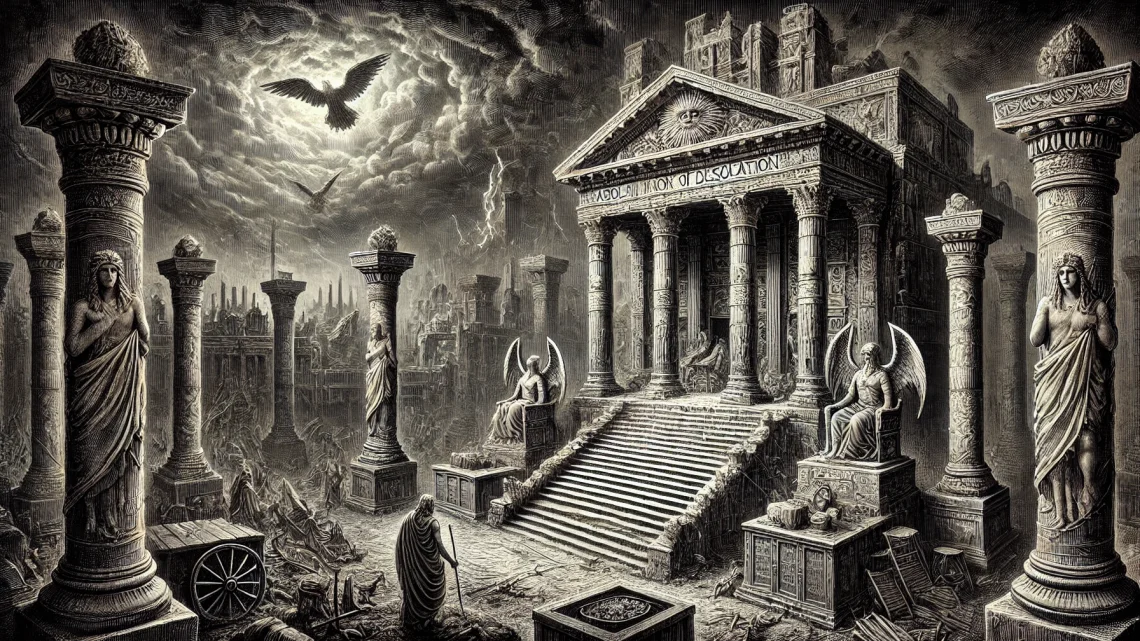The term “abomination of desolation”

appears in the Bible and has been the subject of much interpretation and discussion. It is primarily found in the books of Daniel and Matthew. Let’s delve into the scriptural basis, historical interpretations, and potential prophetic implications.
Scriptural Basis
Daniel
The term first appears in the Book of Daniel, specifically in Daniel 9:27, 11:31, and 12:11. The King James Version (KJV) states:
- Daniel 9:27: “And he shall confirm the covenant with many for one week: and in the midst of the week he shall cause the sacrifice and the oblation to cease, and for the overspreading of abominations he shall make it desolate, even until the consummation, and that determined shall be poured upon the desolate.”
- Daniel 11:31: “And arms shall stand on his part, and they shall pollute the sanctuary of strength, and shall take away the daily sacrifice, and they shall place the abomination that maketh desolate.”
- Daniel 12:11: “And from the time that the daily sacrifice shall be taken away, and the abomination that maketh desolate set up, there shall be a thousand two hundred and ninety days.”
Matthew
Yeshua also references the abomination of desolation in Matthew 24:15-16:
- Matthew 24:15-16: “When ye therefore shall see the abomination of desolation, spoken of by Daniel the prophet, stand in the holy place, (whoso readeth, let him understand:) Then let them which be in Judaea flee into the mountains.”
Historical Interpretations
Antiochus IV Epiphanes
Many scholars and historians believe that the initial fulfillment of Daniel’s prophecy occurred during the reign of Antiochus IV Epiphanes around 167 BCE. Antiochus desecrated the Second Temple in Jerusalem by erecting an altar to Zeus and sacrificing swine on it. This act is considered an abomination because it defiled the holy place of Yehovah.
Roman Destruction of the Temple
Another significant historical interpretation points to the destruction of the Second Temple by the Romans in 70 CE. The Roman armies, led by Titus, destroyed the temple and ended the Jewish sacrificial system, which some believe fulfills Yeshua’s prophecy in Matthew.
Prophetic Implications
Future Fulfillment
Many believe that the abomination of desolation will have a future fulfillment during the end times. This interpretation suggests that a future Antichrist will desecrate a rebuilt temple in Jerusalem, signaling the beginning of a period of great tribulation. This view is supported by the belief in a future restoration of the sacrificial system and a literal temple in Jerusalem.
Summary
The abomination of desolation is a term with deep historical and prophetic significance. Rooted in the prophecies of Daniel and referenced by Yeshua, it has been associated with events such as the desecration of the Second Temple by Antiochus IV Epiphanes and the Roman destruction of the temple in 70 CE. Many also anticipate a future fulfillment involving a desecration of a rebuilt temple in Jerusalem, marking the beginning of the end times tribulation.
By understanding these interpretations, we gain insight into the historical and future events that shape our understanding of biblical prophecy.

